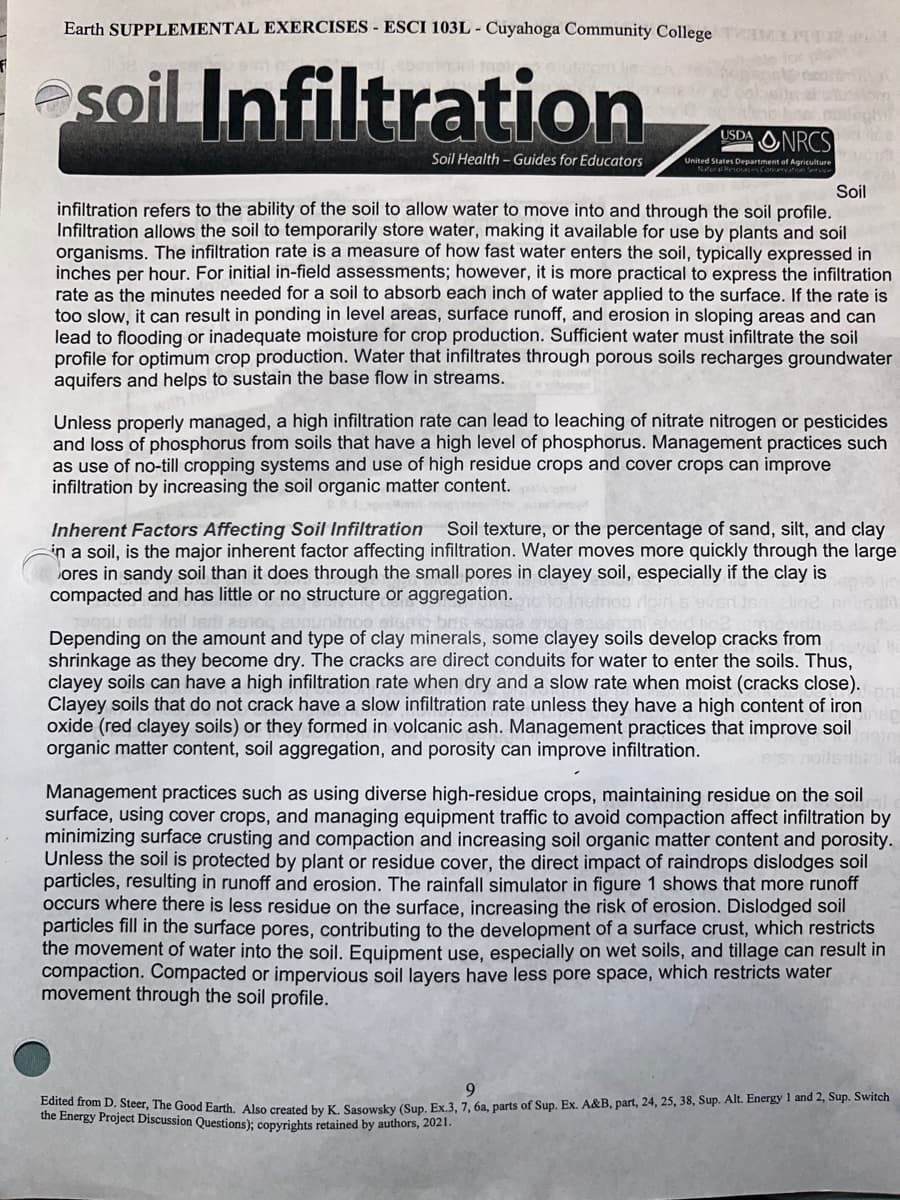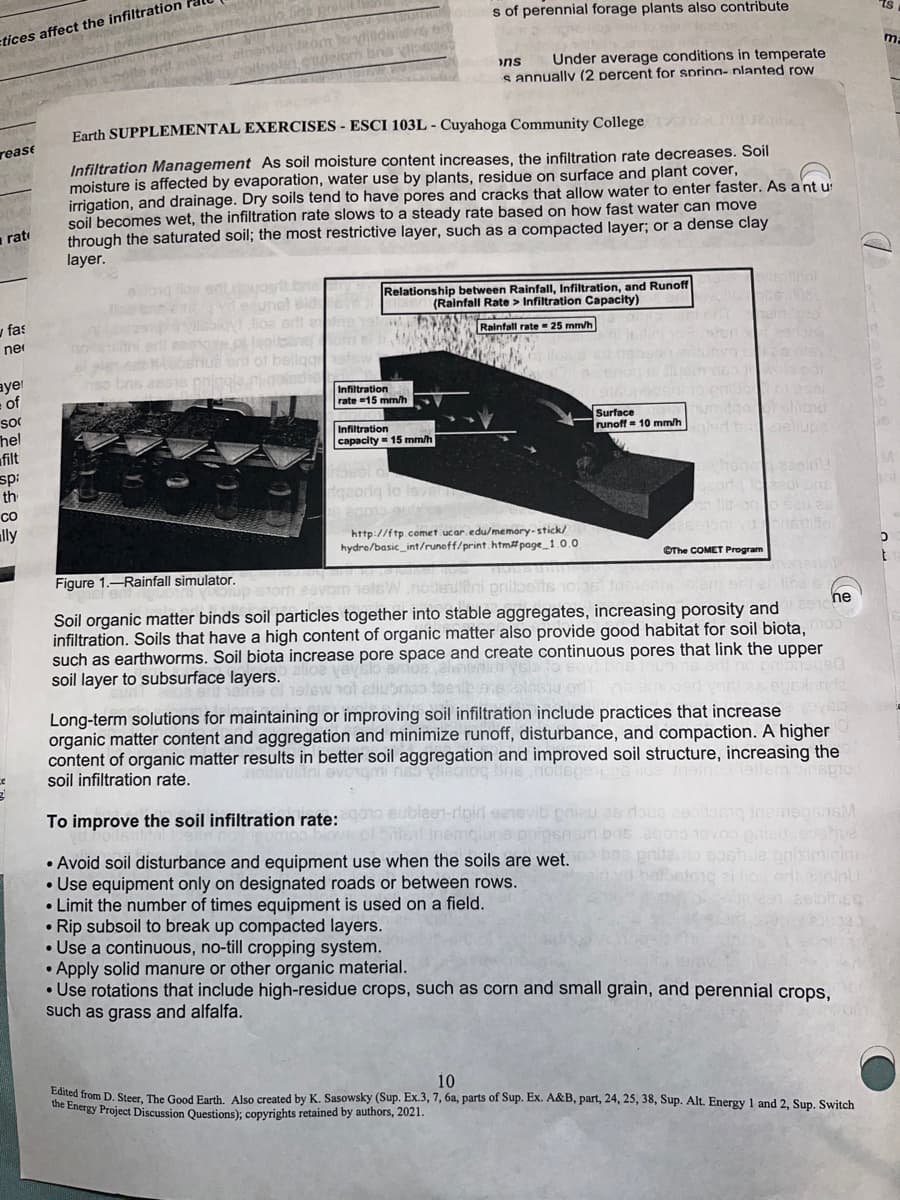Earth SUPPLEMENTAL EXERCISES - ESCI 103L - Cuyahoga Community College Tax Soil Infiltration Soil Health-Guides for Educators USDA NRCS United States Department of Agriculture Natural Resources Comervation Soil infiltration refers to the ability of the soil to allow water to move into and through the soil profile. Infiltration allows the soil to temporarily store water, making it available for use by plants and soil organisms. The infiltration rate is a measure of how fast water enters the soil, typically expressed in inches per hour. For initial in-field assessments; however, it is more practical to express the infiltration rate as the minutes needed for a soil to absorb each inch of water applied to the surface. If the rate is
Earth SUPPLEMENTAL EXERCISES - ESCI 103L - Cuyahoga Community College Tax Soil Infiltration Soil Health-Guides for Educators USDA NRCS United States Department of Agriculture Natural Resources Comervation Soil infiltration refers to the ability of the soil to allow water to move into and through the soil profile. Infiltration allows the soil to temporarily store water, making it available for use by plants and soil organisms. The infiltration rate is a measure of how fast water enters the soil, typically expressed in inches per hour. For initial in-field assessments; however, it is more practical to express the infiltration rate as the minutes needed for a soil to absorb each inch of water applied to the surface. If the rate is
Applications and Investigations in Earth Science (9th Edition)
9th Edition
ISBN:9780134746241
Author:Edward J. Tarbuck, Frederick K. Lutgens, Dennis G. Tasa
Publisher:Edward J. Tarbuck, Frederick K. Lutgens, Dennis G. Tasa
Chapter1: The Study Of Minerals
Section: Chapter Questions
Problem 1LR
Related questions
Question
What surface management practices affect the infiltration rate ? Be specific
Use the the following photos to answer the question

Transcribed Image Text:Earth SUPPLEMENTAL EXERCISES ESCI 103L - Cuyahoga Community College M
soil Infiltration
Soil Health-Guides for Educators
for
USDA NRCS
United States Department of Agriculture
Resources Conservation Service
Soil
infiltration refers to the ability of the soil to allow water to move into and through the soil profile.
Infiltration allows the soil to temporarily store water, making it available for use by plants and soil
organisms. The infiltration rate is a measure of how fast water enters the soil, typically expressed in
inches per hour. For initial in-field assessments; however, it is more practical to express the infiltration
rate as the minutes needed for a soil to absorb each inch of water applied to the surface. If the rate is
too slow, it can result in ponding in level areas, surface runoff, and erosion in sloping areas and can
lead to flooding or inadequate moisture for crop production. Sufficient water must infiltrate the soil
profile for optimum crop production. Water that infiltrates through porous soils recharges groundwater
aquifers and helps to sustain the base flow in streams.
Unless properly managed, a high infiltration rate can lead to leaching of nitrate nitrogen or pesticides
and loss of phosphorus from soils that have a high level of phosphorus. Management practices such
as use of no-till cropping systems and use of high residue crops and cover crops can improve
infiltration by increasing the soil organic matter content.
Inherent Factors Affecting Soil Infiltration
Soil texture, or the percentage of sand, silt, and clay
in a soil, is the major inherent factor affecting infiltration. Water moves more quickly through the large
ores in sandy soil than it does through the small pores in clayey soil, especially if the clay is
compacted and has little or no structure or aggregation.
Depending on the amount and type of clay minerals, some clayey soils develop cracks from
shrinkage as they become dry. The cracks are direct conduits for water to enter the soils. Thus,
clayey soils can have a high infiltration rate when dry and a slow rate when moist (cracks close).
Clayey soils that do not crack have a slow infiltration rate unless they have a high content of iron
oxide (red clayey soils) or they formed in volcanic ash. Management practices that improve soil
organic matter content, soil aggregation, and porosity can improve infiltration.
d-pa
Management practices such as using diverse high-residue crops, maintaining residue on the soil
surface, using cover crops, and managing equipment traffic to avoid compaction affect infiltration by
minimizing surface crusting and compaction and increasing soil organic matter content and porosity.
Unless the soil is protected by plant or residue cover, the direct impact of raindrops dislodges soil
particles, resulting in runoff and erosion. The rainfall simulator in figure 1 shows that more runoff
occurs where there is less residue on the surface, increasing the risk of erosion. Dislodged soil
particles fill in the surface pores, contributing to the development of a surface crust, which restricts
the movement of water into the soil. Equipment use, especially on wet soils, and tillage can result in
compaction. Compacted or impervious soil layers have less pore space, which restricts water
movement through the soil profile.
9
Edited from D. Steer, The Good Earth. Also created by K. Sasowsky (Sup. Ex.3, 7, 6a, parts of Sup. Ex. A&B, part, 24, 25, 38, Sup. Alt. Energy 1 and 2, Sup. Switch
the Energy Project Discussion Questions); copyrights retained by authors, 2021.

Transcribed Image Text:tices affect the infiltration
rease
rat
s of perennial forage plants also contribute
ons
Under average conditions in temperate
s annually (2 percent for spring- planted row
Earth SUPPLEMENTAL EXERCISES - ESCI 103L - Cuyahoga Community College
Infiltration Management As soil moisture content increases, the infiltration rate decreases. Soil
moisture is affected by evaporation, water use by plants, residue on surface and plant cover,
irrigation, and drainage. Dry soils tend to have pores and cracks that allow water to enter faster. As ant u
soil becomes wet, the infiltration rate slows to a steady rate based on how fast water can move
through the saturated soil; the most restrictive layer, such as a compacted layer; or a dense clay
layer.
wfas
ne
ayer
of
sor
Thel
filt
sp:
th
Co
vdedunat did
Vilsbigy! Bloe orll a
abshua ent of beligg
Relationship between Rainfall, Infiltration, and Runoff
(Rainfall Rate > Infiltration Capacity)
Infiltration
rate=15 mm/h
Infiltration
capacity 15 mm/h
georiq lo lo
Rainfall rate 25 mm/h
Surface
sel
numigo of shion
runoff 10 mm/h
gled bellups
lly
Figure 1.--Rainfall simulator.
up storm eevom
http://ftp.comet.ucar.edu/memory-stick/
hydro/basic_int/runoff/print.htm#page_1.0.0
nillini grillosits 10
no tib
©The COMET Program
asia or
ne
Cribrisged
Soil organic matter binds soil particles together into stable aggregates, increasing porosity and
infiltration. Soils that have a high content of organic matter also provide good habitat for soil biota,
such as earthworms. Soil biota increase pore space and create continuous pores that link the upper
soil layer to subsurface layers.
yer
Long-term solutions for maintaining or improving soil infiltration include practices that increase
organic matter content and aggregation and minimize runoff, disturbance, and compaction. A higher
content of organic matter results in better soil aggregation and improved soil structure, increasing the
soil infiltration rate.
To improve the soil infiltration rate:
วาว eubiast-ripid canevib pnieu as doua cooltong insineesh M
tical inemqiupe pripns basa evo grative
bos pritano soshua poisiminim
Avoid soil disturbance and equipment use when the soils are wet.
•Use equipment only on designated roads or between rows.
•Limit the number of times equipment is used on a field.
Rip subsoil to break up compacted layers.
• Use a continuous, no-till cropping system.
.
Apply solid manure or other organic material.
Use rotations that include high-residue crops, such as corn and small grain, and perennial crops,
such as grass and alfalfa.
10
Edited from D. Steer, The Good Earth. Also created by K. Sasowsky (Sup. Ex.3, 7, 6a, parts of Sup. Ex. A&B, part, 24, 25, 38, Sup. Alt. Energy 1 and 2, Sup. Switch
the Energy Project Discussion Questions); copyrights retained by authors, 2021.
t
m
Expert Solution
This question has been solved!
Explore an expertly crafted, step-by-step solution for a thorough understanding of key concepts.
Step by step
Solved in 3 steps

Recommended textbooks for you

Applications and Investigations in Earth Science …
Earth Science
ISBN:
9780134746241
Author:
Edward J. Tarbuck, Frederick K. Lutgens, Dennis G. Tasa
Publisher:
PEARSON

Exercises for Weather & Climate (9th Edition)
Earth Science
ISBN:
9780134041360
Author:
Greg Carbone
Publisher:
PEARSON

Environmental Science
Earth Science
ISBN:
9781260153125
Author:
William P Cunningham Prof., Mary Ann Cunningham Professor
Publisher:
McGraw-Hill Education

Applications and Investigations in Earth Science …
Earth Science
ISBN:
9780134746241
Author:
Edward J. Tarbuck, Frederick K. Lutgens, Dennis G. Tasa
Publisher:
PEARSON

Exercises for Weather & Climate (9th Edition)
Earth Science
ISBN:
9780134041360
Author:
Greg Carbone
Publisher:
PEARSON

Environmental Science
Earth Science
ISBN:
9781260153125
Author:
William P Cunningham Prof., Mary Ann Cunningham Professor
Publisher:
McGraw-Hill Education

Earth Science (15th Edition)
Earth Science
ISBN:
9780134543536
Author:
Edward J. Tarbuck, Frederick K. Lutgens, Dennis G. Tasa
Publisher:
PEARSON

Environmental Science (MindTap Course List)
Earth Science
ISBN:
9781337569613
Author:
G. Tyler Miller, Scott Spoolman
Publisher:
Cengage Learning

Physical Geology
Earth Science
ISBN:
9781259916823
Author:
Plummer, Charles C., CARLSON, Diane H., Hammersley, Lisa
Publisher:
Mcgraw-hill Education,